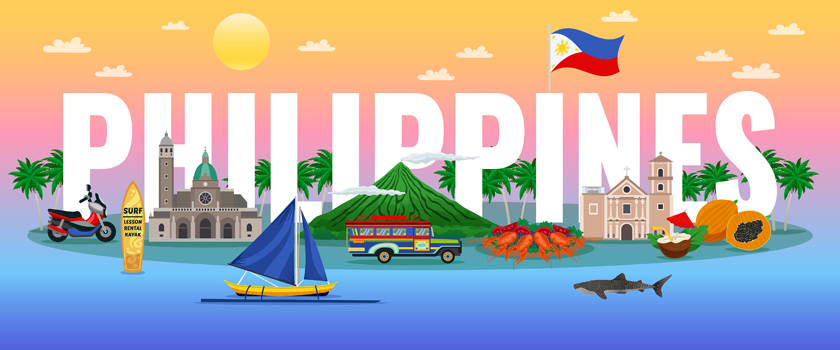The Philippines is a country that is situated in Southeast Asia. It consists of 7,641 islands. The country shares its borders with Brunei, Palau, Vietnam, Malaysia, China, Indonesia, Taiwan, and Japan. Manila is the capital and the largest city is Quezon. It has a very diverse culture with multiple ethnic groups residing there. The Philippines is also famous for its linguistic diversity. It has one national and two official languages.
There are around 120 to 175 languages spoken in the Philippines. The official language according to the current constitution is English and Filipino. The other languages include Waray Waray, Kinarava, Kapampangan, IIokano, Hiligayno, and Cebuaano.
The languages spoken in the Philippines are derived from Malayo-Polynesian roots, but there are many Filipinos who can speak different languages taken from Chinese, Arabic, and Spanish. Catholicism gained popularity in the country when the Spanish ruled them for over 300 years.
The Historical Background of the Philippines
During the Spanish rule in the 19th and 20th centuries, the lingua Franca in the Philippines was Spanish. Filipinos had to quit their language and use Spanish for communication in all aspects of life. When the country came under the rule of Americans, then English became the lingua franca.
All the school courses were translated into English, and English was widely used in business transactions. When the Philippines gained independence, Tagalog was declared the official language in the reign of President Manuel L. Quezon. The Philippines have gone through many leaderships, so their native language is influenced by the Malayo-Polynesian family of languages.
Official Language of Philippines
Tagalog was the official language of the Philippines in 1939. It was widely spoken in the country’s capital. To the South of the Philippines, there are many other languages spoken. The official language of the Philippines was changed to Filipino in 1973 under the presidency of Ferdinand Marcos. It was further elaborated with the development of the 1987 constitution.
The Languages that are Spoken in the Philippines
The Philippines is native to 134 indigenous ethnic groups. The majority population of the Philippines includes 8-10 diverse ethnic groups that have influenced the languages and culture of the country immensely. There are 185 languages with different dialects spoken in the country. Although the official language of the Philippines is Filipino and English, 19 regional languages are also given importance in its constitution.
Filipino is the national language and is widely spoken by many nationalities residing in Filipino. The people of this country were influenced by the English when Britishers invaded the region. All the syllabus at schools and official business transitions in the Philippines are conducted in the English language. At present, English is spoken by around 40 million Filipino.
The Philippines is such a country that didn’t become a Spanish speaking country despite Spanish rule. Yet the Spanish language is still popular in various regions of the world. In the islands of Luzon and Mindanao, the Creoles of the Spanish language are used. The other languages spoken in the country include French, German, Hokkien, Korean, Japanese, and Arabic. Immigrants usually speak these languages.
Flourishment of commerce and trade in the region is the reason that many Filipinos can speak and understand multiple languages like Bahasa Indonesia, Chinese, Japanese, and Bahasa Melayu. It is interesting to note that despite linguistic diversity, The Philippines stands united and people have a clear understanding of languages. The languages that are spoken in the Philippines are not endangered but they are live languages.
Filipino
Filipino is from the Austronesian family of languages. It is the official and national language of the Philippines. It is native to 28 million people and 45 million people used it as its second language. Among the diverse languages spoken in the Philippines, Filipino is the most popular one. The script of Filipino is derived from Latin. In the Muslim majority areas, Filipino is written in Arabic script. People are often confused by the question of whether Tagalog and Filipino are different languages. The answer is they are mutually intelligible. No doubt the Filipino is popular in the Philippines but the operations of the government are done in the English language. Filipino is greatly influenced by foreign and regional languages that include Japanese, Chinese, Malay, Arabic, Spanish, and English. The native speakers of Spanish referred to Filipino to differentiate it from other languages.
Wrapping Up
If you want to visit the Philippines or want to start a business there, you will come across a population of 109 million people that speaks Filipino. To connect and target such an enormous population, you will require the translation of your traveling and business documents that can only be done by a reliable translation company. CCJK is here for you. We have a team of native translators that are aware of linguistic and cultural intricacies and provide you with impeccable translation services in 120 languages. Contact us for more details!
Resources
How Many Languages are Spoken in China
How Many Languages are Spoken in India
What Languages are Spoken in Brazil?
What Languages are Spoken in Israel?
What Language is spoken in Iceland?
What Languages Spoken in the Philippines
Most Spoken Languages in Africa
Most Endangered Languages in the World
Official Languages of the United Nations
most useful languages for Business?
Exploring the Languages of Future



